Diodes!

Diodes are nonlinear circuit elements.
andreas zlr
$I$ vs $V$

Sparkfun

Diode - The arrow points in the forward direction.
A simple model of diodes:
- $V_\text{F}\lt V$: Current flows readily with little or no resistance.
- $-V_\text{BR}\lt V \lt V_\text{F}$: No current flows.
- $ V < -V_\text{BR}$: Current flows readily with little or no resistance.
Maximum current: 20 mA. (If you know the voltage to be supplied, you can size a resistor to limit the current through the diode.)

Light Emitting Diode (LED)
$V_f$ depends on the color: 1.6 V (Red)..(Orange)..(Yellow)..(Green) 2.5 V (Blue)..("White") 4 V
Operating current ~10 mA.

Zener diode - These are intentionally operated in reverse bias. They use the breakdown voltage, $V_\text{BR}$. A "noisy" voltage source can be clipped to a smooth$V_\text{BR}$ DC voltage level.
The breakdown voltage can be tuned by "doping" (chosen chemical impurities) and maximum current can be several 100 A.
Current rectifying diodes - High current diodes can be put together into a "Graetz bridge" to convert AC to DC
WS2 Diodes
Here is WS2 - Diodes.
On page 2, parts L and M, the breakdown voltages of the zener diodes are not specified. Let's take them to be $V_\text{br}=3.0$ V.
Our assumptions about diodes
- If the voltage in the circuit across the diode would be more than +0.5 V (in the "forward" direction), then the diode will conduct, and enough current will flow such that the voltage drop across the diode will stay at 0.5 V.
- If the voltage in the circuit across the diode is less than +0.5 V (including any negative voltage), then no current flows through the diode.
A zener diode:
- will conduct if a forward voltage of 0.5 V or greater is applied. Just like a regular diode,
- It also has a reverse "breakdown" voltage. If the breakdown voltage is 3.6 V, then if the voltage in the circuit across such a zener diode is less than -3.6 V in the forward direction (or, if you like, more than 3.6 V in the reverse direction) then the diode will conduct and stabilize at its breakdown voltage.
Hint: It's useful to:
- start by pretending that the diode is not conducting. Calculate what the voltage would be on either side of the diode.
- (for zener and regular diodes) If the voltage difference exceeds the forward voltage drop of 0.5 V (both zener and regular diodes), then you know it *will* conduct, and you can set the voltage drop across it to 0.5 V
Otherwise assume it's not conducting.
- For the zener diodes, if the voltage difference exceeds the breakdown voltage in the reverse direction, then you you can set the voltage drop across it to its $V_\text{br}$.
Otherwise assume it's not conducting.

